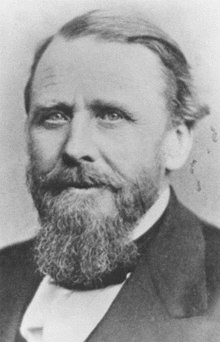University of Denver finds John Evans ‘central’ to conditions for massacre

Source: Colorado State Archives
John Evans
November 4, 2014
The University of Denver’s John Evans Study Committee released a report Monday that finds Evans, the founder of both DU and Northwestern, “deeply culpable” in the Sand Creek Massacre, an 1864 event in which American soldiers killed about 150 Cheyenne and Arapaho people.
The DU report disagrees “strongly” with portions of NU’s own report on the topic, released in May, which concluded Evans was not directly involved in the planning of the massacre and would have opposed the attack. The NU report also said the University has ignored Evans’ “significant moral failures,” including his refusal to criticize the attack.
Evans, who was governor and superintendent of Indian affairs in the Colorado Territory where the massacre occurred, has been the subject of scrutiny from committees at both universities since 2013.
NU’s John Evans Study Committee was appointed by Provost Dan Linzer in February 2013 after students pushed the University to address its history. An NU faculty member then contacted a DU colleague asking about similar efforts at the school. DU faculty members then formed their own study committee with the support of the university’s administration, according to the DU report.
DU’s report, which focused on events leading up to the massacre, concluded that Evans shared responsibility because he failed to promote peace, claimed Native American tribes were planning to fight with white settlers in the region and directly influenced conditions in the territory that made attacks on Native Americans appear justified.
Nancy Wadsworth, chair of the committee and a DU political science professor, told The Daily the DU committee “defined culpability in a broader sense whereas Northwestern defined culpability in a narrow instrumental sense” that focused more on whether Evans knew about the attack or co-conspired in it with Col. John Chivington, the military official who planned and carried out the massacre.
“If we pull back to the broader question of who was the top official, in the top civil and political authority in the territory,” Wadsworth said, “what were the patterns of action and decisions that led up to the massacre? We believe there’s more than enough evidence to demonstrate that John Evans shared culpability for the fact that the massacre occurred.”
The DU report disagreed with the NU report’s claims that Evans would have opposed the massacre if he had known it was being planned. The DU committee argued in its report that the “histrionic and inflammatory verbiage” Evans used in his letters indicated his “keen enthusiasm for a ruthless, ‘punishing’ winter attack on Indians.”
NU’s report stated that “John Evans … was one of several individuals who, in serving a flawed and poorly implemented federal Indian policy, helped create a situation that made the Sand Creek Massacre possible.” In Monday’s report, the DU committee said Evans, holding the top political office in the territory at the time, had more responsibility in “creating the conditions in which the massacre was possible and even likely.”
“It is all the actions he undertook and the attitude that he maintained before the massacre that not only reflected ‘indifference to the suffering inflicted on Cheyennes and Arapahos,’ but promoted the suffering,” the DU committee stated in its report.
Wadsworth said Evans’ responsibility in the massacre is “different in character but comparable in degree” to actually planning the attack.
She emphasized the DU report was not meant to prompt an “adversarial relationship” between the university and NU. The DU committee, upon reading NU’s report in May, decided to focus its own report less on parts of history NU covered, such as Evans’ biography and career, she said.
“(We) focused on the areas where we think that the evidence suggests different conclusions,” Wadsworth said.
At NU, public interest about the John Evans Study Committee’s work led to the fall 2013 creation of the Native American Outreach and Inclusion Task Force to recommend actions the University should take in light of the committee’s findings.
The task force consists of students, faculty and administrators and is expected to release its report this month, which will coincide with the 150th anniversary of the Sand Creek Massacre.
November also marks Native American Heritage Month, during which the Native American and Indigenous Student Alliance plans to hold various events commemorating the anniversary and discussing Evans’ role in the massacre.
NAISA commented on DU’s report Monday on the group’s Facebook page, saying the new report “offers a humanizing narrative.”
Email: jkuang@u.northwestern.edu
Twitter: @jeannekuang
Previous stories on this topic:
In Focus: Students demand Native American studies, recognition of Evans’ role in Sand Creek Massacre
Schapiro: ‘Productive’ open forum led to fast-tracking of second John Evans committee
Northwestern releases John Evans report, committee concludes he had no direct involvement in massacre but University ignored ‘significant moral failures’


